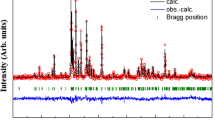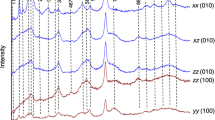Abstract
This paper describes single-crystal measurements on a crystal plate cut from a naturally-occurring almandine-rich single crystal (Alm69Pyr19Spe8Gro4) from Wrangell Alaska. The objective was to measure the mean-squared-displacement (msd) tensor precisely using Mössbauer spectroscopy. Parallel quantum-mechanical calculations based on X-ray determined atomic displacement parameters and Mössbauer parameters from polycrystalline measurements indicated that the msd tensor should display significant anisotropy, easily measurable within the precision of the Mössbauer experiment. For each single-crystal orientation the observed Mössbauer spectrum represents a macroscopic quantity that is the average over six symmetry-related (local) dodecahedral sites in which the high-spin Fe2+ ions reside. The anisotropy in the measured msd tensor is, nevertheless, unequivocal. Furthermore, the magnitudes of the Mössbauer-determined msd principal values exceed those of the corresponding X-ray-determined quantities by a factor 3.7. The equivalent recoilless fractions are also anisotropic and consequently one observes the Gol’danskii–Karyagin Effect (GKE), as manifested by an asymmetric quadrupole doublet in polycrystalline absorbers. Moreover, the line widths of the two quadrupole lines are markedly different but angle invariant. This is interpreted as implying that, in addition to anisotropy in the msd tensor, differential spin–spin relaxation is present in the \( m = \pm 3/2 \leftrightarrow \pm 1/2 \) and \( m = \pm 1/2 \leftrightarrow \pm 1/2,\, \mp 1/2 \) nuclear transitions. While both effects contribute to the quadrupole asymmetries observed in Mössbauer spectra of polycrystalline almandine, the GKE is apparently predominant.






Similar content being viewed by others
References
Amthauer G, Annersten H, Hafner SS (1976) The Mössbauer spectrum of 57Fe in silicate garnets. Z Kristallog 143:14–55
Armbruster T, Geiger CA, Lager GA (1992) Single-crystal X-ray structure study of synthetic pyrope almandine garnets at 100 and 293 K. Am Miner 77:512–521
Blume M (1965) Magnetic relaxation and asymmetric quadrupole doublets in the Mössbauer effect. Phys Rev Lett 14:96–98
Blume M, Tjon JA (1968) Mössbauer spectra in a fluctuating environment. Phys Rev 165:446–456
Brand RN (1994) Program NORMOS. Distributed by Wissenschaftliche Elektronik, GMBH, Germany
Bull JN, Robinson WT, Tennant WC (2009) Ferrous ammonium sulphate hexahydrate revisited: a combined 57Fe Mössbauer and X-ray single crystal study. Hyperfine Interact 194:347–366
Bull JN, Fitchett CM, Tennant WC (2011) Microscopic 57Fe electric-field-gradient and anisotropic mean-squared-displacement tensors: ferrous chloride tetrahydrate. Hyperfine Interact 198:273–293
Bykov GA, Hein PZ (1963) Calculation of parameters of experimental spectra of resonance absorption of gamma quanta in crystals. Sov Phys JETP 16:646–651
Collins RL, Travers JC (1967) The electric field gradient tensor. In: Gruverman IJ (ed) Mössbauer effect methodology. Plenum Press, New York, vol 3, pp 123–161
De Grave E, Van Alboom A (1991) Evaluation of ferrous and ferric Mössbauer fractions. Phys Chem Miner 18:337–342
de Oliveira JCP, Kunrath JI, Vasquez A (1987) The Mössbauer effect in natural almandine: Fe3Al2(SiO4)3. Phys Scr 36:526–528
Edmonds AR (1974) Angular momentum in quantum mechanics. Princeton University Press, Princeton
Geiger CA, Armbruster Th, Lager GA, Jiang K, Lottermoser W, Amthauer G (1992) A combined temperature dependent 57Fe Mössbauer and single crystal X-ray diffraction study of synthetic almandine: evidence for the Gol’danskii–Karyagin effect. Phys Chem Miner 19:121–126
Geiger CA, Grodzicki M, Amthauer G (2003) The crystal chemistry and FeII-site properties of aluminosilicate garnet solid solutions as revealed by Mössbauer spectroscopy and electronic structure calculations. Phys Chem Miner 30:280–292
Gibb TC (1978) The orientation of the electric-field-gradient tensor from single crystal Mössbauer measurements. J Chem Soc, Dalton Trans 7:743–752
Golding RM (1969) Applied wave mechanics. D Van Nostrand Co., London
Golding RM, Tennant WC (2008) Quantum mechanics in chemical physics: an exploration. Common Ground Publishing, Altona
Grant RW, Housley RM, Gonser U (1969) Nuclear electric field gradient and mean square displacement of the iron sites in sodium nitroprusside. Phys Rev 178:523–530
Gütlich P, Link R, Trautwein A (1978) Mössbauer spectroscopy and transition metal chemistry. Springer, Berlin
Housley RM, Grant RW, Gonser U (1969) Coherence and polarization effects in Mössbauer absorption by single crystals. Phys Rev 178:514–522
Lyubutin IS, Dodokin AP (1971) Temperature dependence of the Mössbauer Effect for Fe2+ in dodecahedral coordination in garnet. Sov Phys Crystallogr 18:1091–1092
McCammon CA, Chinn IL, Gurney JJ, McCallum ME (1998) Ferric iron content of mineral inclusions in diamonds from George Creek, Colorado determined using Mössbauer spectroscopy. Contrib Miner Petrol 133:30–37
McCammon CA, Tennant WC, Miletich R (2000) A new method for single crystal measurements: application to Mössbauer spectra of mineral inclusions in diamond. Hyperfine Interact 126:241–245
Murad E, Wagner FE (1987) The Mössbauer spectrum of almandine. Phys Chem Miner 14:264–269
Novak GA, Gibbs GV (1971) The crystal chemistry of the silicate garnets. Am Miner 56:791–825
Prandl W (1971) Die magnetische Struktur und die Atomparameter des Almandins. Al2Fe3(SiO4)3. Z Kristallogr 134:333–343
Prandl W, Wagner F (1971) Die Orientierung des elektrischen Feldgradienten und des innere Magnetfeld beim Almandin. Z Kristallogr 134:344–349
Rae AD (1969) Relationships between the experimental Hamiltonian and point symmetry of a paramagnetic species in a crystal. J Chem Phys 50:2672–2685
Tennant WC (1992) Analysis of single-crystal Mössbauer data in low-symmetry 57Fe centres. J Phys: Condens Matter 4:6993–7008
Tennant WC, McGavin DG, Patterson KH (1992) Theory and FORTRAN programme for analysis of Mössbauer single crystal data. NZ Inst for Ind Res Dev, Report IRL No 8
Weil JA (1973) Use of symmetry-related crystal sites for measuring tensor properties in magnetic resonance. J Magn Reson 10:391–393
Weil JA, Buch T, Clapp JE (1973) Crystal point group symmetry and microscopic tensor properties in magnetic resonance spectroscopy. Adv Magn Reson 6:183–257
Woodland AB, Droop G, O’Neill H, St C (1995) Almandine-rich garnet from near Collobrières, southern France, and its petrological significance. Eur J Mineral 7:187–194
Zherebetskyy D, Lebernegg S, Amthauer G, Grodzicki M (2012) Magnetic structure of almandine. Phys Chem Miner 39:351–361
Zimmermann R (1975) A method for evaluation of single crystal 57Fe Mössbauer spectra (FeCl2·4H2O). Nucl Instr Meth 128:537–543
Zimmermann R (1983) In: Thosar BV, Srivastava JK, Iyengar PK, Bhargava SC (eds) Advances in Mössbauer spectroscopy. Elsevier, Amsterdam, pp 273–315
Acknowledgments
We wish to thank the following: R Spiers (Geology Dept, University of Canterbury) for help with crystal preparation, W Robinson for the space group and cell edge determination, H Schultz and D Ojwang (both at Bayerisches Geoinstitut) for cutting/polishing of the crystal and electron microprobe analysis, respectively, and H Spiering (Mainz) for useful comments and discussions, particularly regarding the masking of the detector. JNB gratefully acknowledges financial support from a Tertiary Education Top Achiever Scholarship. WCT would especially like to thank the charming but unnamed young ladies of Wrangell, Alaska, from whom the crystal used in these studies was purchased at the port of Wrangell in 2008. We thank C A Geiger and an anonymous referee for their helpful reviews, and C A Geiger for bringing the Zherebetskyy et al. paper to our attention.
Author information
Authors and Affiliations
Corresponding author
Appendix
Appendix
Thickness corrections
We outline briefly the equations and procedures for thickness corrections following Housley et al. (1969) and Zimmermann (1983) (see also Golding and Tennant (2008), vol II, p. 810). We define useful quantities in terms of a polarization operator, σ, its eigenvalues σ 1 and σ 2 and a “thickness”, p (effectively the cross section at resonance), where
In the most general case, thickness is polarization dependent and the degree of polarization, a, is defined as
hence
In the almandine case, since polarization is zero, we have simply σ1 = σ2 = p.
Assuming that the gamma-ray source is a single line and unpolarized, the dimensionless absorption areas, S, can be expressed by the Bykov and Hein (1963) equation (Housley et al. 1969; Zimmermann 1983; Golding and Tennant 2008), namely
In Eq. 31, I 0 (x) and I 1 (x) are modified Bessel functions of the first kind (i.e., with imaginary argument) of order 0 and 1, respectively. An expansion of Eq. 31 utilising Eq. 30 for the zero polarization case and its more useful inversion as detailed by Bull et al. (2009) are as follows:
The inverse Eq. 33, is usually sufficient to obtain a convergent thickness correction. The correction can be checked easily by substitution in Eq. 32 for which a few extra terms, given in Bull et al. (2009), can be useful.
Rights and permissions
About this article
Cite this article
Bull, J.N., Tennant, W.C., Ballaran, T.B. et al. Anisotropic mean-squared-displacement tensor in cubic almandine garnet: a single crystal 57Fe Mössbauer study. Phys Chem Minerals 39, 561–575 (2012). https://doi.org/10.1007/s00269-012-0512-1
Received:
Accepted:
Published:
Issue Date:
DOI: https://doi.org/10.1007/s00269-012-0512-1




